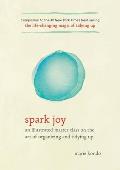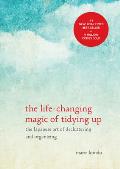In the spring, I was at the check-out counter of Northshire Bookstore in Manchester, VT, mostly buying gifts for other people, when I
grabbed a copy of Marie Kondo’s best-selling mega hit The Life-Changing Magic of Tidying Up: The Japanese Art of Decluttering
and Organizing. I figured I should finally read it for myself to find out
what all the fuss was about! We have lived in our home for 22 years and raised
two kids here, so we could definitely use some decluttering, and I like having
things organized. Kondo has some good advice in this slim book and some
interesting ways of approaching these tasks, but I also came away thinking
she’s a little bit nutty!
There are a couple of unique approaches about her KonMari
Method. The one aspect I am most likely to use from her book is that she
focuses on what to keep instead of
what to get rid of. I am probably like most people in that I approach
decluttering with an eye on what I can throw away or donate – flipping through
my closet the night before a charity pick-up, thinking, “Hmmm…I haven’t worn
this in years, this doesn’t fit anymore, etc.” Conversely, Marie Kondo
recommends going through your stuff and for each item, considering whether it
sparks joy. This was intriguing to me, since I like to focus on joy in my life,
but – again thinking of clothing – I know I keep items that fit me and are OK,
but I don’t really love. Kondo says to get rid of those and keep only what
sparks joy.
The other unique part of her approach that won’t work for me
but might for other people is that she does not recommend going room-by-room or
one closet or bookcase or dresser at a time. Rather, she recommends working
through one category of item at a time. So, when you are decluttering and
organizing your clothing, she says to pull out ALL of your clothes at once –
every item in closets, dressers, etc. – and go through it all at once, holding
every single item to decide if it sparks joy. Same with books – every single
book in your house! That makes logical sense, but with my very limited physical
stamina, I would manage it for an hour or 90 minutes and then run out of energy
and be stuck with all my clothes or books in the middle of the room! But I can
see what she’s getting at – it’s hard to make progress one small bit at a time.
I do think she is right about having to take everything out of the closet or
dresser or wherever because I know I don’t accomplish much when I try to go
through items still packed together.
So, why did I say that Marie Kondo is a little nutty? Well,
she goes pretty far afield in her recommendations on storage and organization,
after you’ve finished decluttering. She is really
into folding and says everything should be folded and stored standing on its
edge like books (but she is talking about clothing). She also fervently
believes that your stuff needs to “rest” when you are not using it. Here’s what
she says to one client:
“I pointed to the balled-up socks. ‘Look at them carefully. This should be a time for them to rest. Do you really think they can get any rest like that?’ ”
She also recommends completely emptying your purse every
single day when you get home – again, so that it can rest in between uses. She
says we should thank our things for their service – at the end of the day and
before we get rid of them. She concludes, toward the end of the book, with
this:
“Everything you own wants to be of use to you. Even if you throw it away or burn it, it will only leave behind the energy of wanting to be of service. Freed from its physical form, it will move about your world as energy, letting other things know that you are a special person, and come back to you as the thing that will be of most use to who you are now, the thing that will bring you the most happiness.”
O.K. I think I am just a bit too logical and analytical for
that! She also focuses on attaining an ideal that I’m really not interested in
– a very spare home with nothing out in the open and all items able to be
stored in a single closet. Maybe this is somewhat of a cultural difference, as
I know that is more of a Japanese ideal than an American one. I enjoy being
surrounded by things I love. Of course, as an avid reader, I can’t imagine
purging books as thoroughly as she suggests, and I have heard other book lovers
say the same. I love having a full
bookcase in every room of my home! Those definitely spark joy. Still, I could
certainly use some culling and decluttering.
Marie Kondo’s book spent 99 weeks on the New York Times
best-seller list and sold over six million copies worldwide, so it seems that
she and her methods are very, very popular. She offers some excellent advice in
this slim volume (and she wrote a sequel, Spark
Joy: An Illustrated Master Class on the Art of Organizing and Tidying Up,
for those who want more detail). Some of her approaches are different from what
you normally read in decluttering and organizing advice, though her methods may
not be practical for everyone. Although I don’t think I’ll be thanking my
possessions for their service or emptying my purse every day, I do hope to put
some of her advice into practice.
206 pages, Ten Speed Press (Berkeley)
I’m interested to hear what YOU think of Marie Kondo’s
methods! Have you tried any of the approaches in The Life Changing Magic of Tidying Up? What were your experiences?
I purchased this book myself.
Note: This post contains affiliate links. Purchases from
these links provide a small commission to me (pennies per purchase), to help
offset the time I spend writing for this blog, at no extra cost to you.
Spark Joy: An Illustrated Master Class on the Art of Organizing and Tidying Up
 by Marie KondaoHardcover
by Marie KondaoHardcover

 by Marie KondaoHardcover
by Marie KondaoHardcoverOr purchase from Northshire Bookstore in Manchester, VT:




I have heard so much about this book, but your review really explained it to me. I also like the idea of thinking about what to keep (what brings joy) and I do like a good de-cluttering session, but this book sounds like it's a bit nutty.
ReplyDeleteMore than a bit! ha ha It's a very popular book with lots of avid followers...but there are also some hilarious 1 star reviews on Goodreads!
Delete